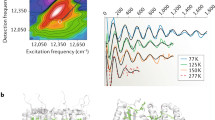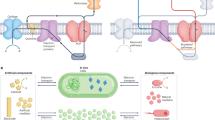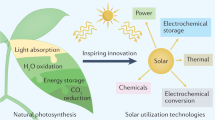Abstract
The past decade has seen rapid advances in our understanding of how coherent and vibronic phenomena in biological photosynthetic systems aid in the efficient transport of energy from light-harvesting antennas to photosynthetic reaction centres. Such coherence effects suggest strategies to increase transport lengths even in the presence of structural disorder. Here we explore how these principles could be exploited in making improved solar cells. We investigate in depth the case of organic materials, systems in which energy and charge transport stand to be improved by overcoming challenges that arise from the effects of static and dynamic disorder — structural and energetic — and from inherently strong electron–vibration couplings. We discuss how solar-cell device architectures can evolve to use coherence-exploiting materials, and we speculate as to the prospects for a coherent energy conversion system. We conclude with a survey of the impacts of coherence and bioinspiration on diverse solar-energy harvesting solutions, including artificial photosynthetic systems.
This is a preview of subscription content, access via your institution
Access options
Subscribe to this journal
Receive 12 print issues and online access
$259.00 per year
only $21.58 per issue
Buy this article
- Purchase on Springer Link
- Instant access to full article PDF
Prices may be subject to local taxes which are calculated during checkout







Similar content being viewed by others
References
Zhu, X., Long, S. & Ort, D. R. Improving photosynthetic efficiency for greater yield. Annu. Rev. Plant Biol. 61, 235–261 (2010).
Tank, M. & Bryant, D. Nutrient requirements and growth physiology of the photoheterotrophic acidobacterium, Chloracidobacterium thermophilum. Front. Microbiol. 6, 226 (2015).
Dubinsky, Z. & Schofield, O. From the light to the darkness: thriving on the light extremes in the oceans. Hydrobiologia 639, 153–171 (2010).
Scholes, G. D., Fleming, G. R., Olaya-Castro, A. & van Grondelle, R. Lessons from nature about solar light harvesting. Nature Chem. 3, 763–774 (2011).
Venkateshvaran, D. et al. Approaching disorder-free transport in high-mobility conjugated polymers. Nature 515, 384–388 (2014).
Chenu, A. & Scholes, G. D. Coherence in energy transfer and photosynthesis. Annu. Rev. Phys. Chem. 66, 69–96 (2015).
Caruso, F., Chin, A. W., Datta, A., Huelga, S. F. & Plenio, M. B. Entanglement and entangling power of the dynamics in light-harvesting complexes. J. Chem. Phys. 131, 105106 (2009).
O'Reilly, E. J. & Olaya-Castro, A. Non-classicality of the molecular vibrations assisting exciton energy transfer at room temperature. Nat. Commun. 5, 3012 (2014).
Walschaers, M., Schlawin, F., Wellens, T. & Buchleitner, A. Quantum transport on disordered and noisy networks: an interplay of structural complexity and uncertainty. Annu. Rev. Condens. Matter Phys. 7, 223 (2016).
Ke, Y., Liu, Y. & Zhao, Y. Visualization of hot exciton energy relaxation from coherent to diffusive regimes in conjugated polymers: a theoretical analysis. J. Phys. Chem. Lett. 6, 1741–1747 (2015).
Markvart, T. Light harvesting for quantum solar energy conversion. Progr. Quantum Electr. 24, 107–186 (2000).
Mülken, O. & Blumen, A. Continuous-time quantum walks: models for coherent transport on complex networks. Phys. Rep. 502, 37–87 (2011).
Park, H. et al. Enhanced energy transport in genetically engineered excitonic networks. Nat. Mater. 15, 211–216 (2016).
Blankenship, R. E. Molecular Mechanisms of Photosynthesis (Blackwell, 2002).
Demmig-Adams, B., Garab, G., Adams, W. W. III & Govindjee in Advances in Photosynthesis and Respiration (ed. Govindjee) (Elsevier, 2014).
Bennett, D., Amarnath, K. & Fleming, G. R. A structure-based model of energy transfer reveals the principles of light harvesting in photosystem II supercomplexes. J. Am. Chem. Soc. 135 (2013).
Savoie, B. et al. Unequal partnership: asymmetric roles of polymeric donor and fullerene acceptor in generating free charge. J. Am. Chem. Soc. 136, 2876–2884 (2014).
Engel, G. S. et al. Evidence for wavelike energy transfer through quantum coherence in photosynthetic systems. Nature 446, 782–786 (2007).
Collini, E. et al. Coherently wired light-harvesting in photosynthetic marine algae at ambient temperature. Nature 463, 644–648 (2010).
Panitchayangkoon, G. et al. Long-lived quantum coherence in photosynthetic complexes at physiological temperature. Proc. Natl Acad. Sci. USA 107, 12766–12770 (2010).
Fassioli, F., Dinshaw, R., Arpin, P. C. & Scholes, G. D. Photosynthetic light harvesting: excitons and coherence. J. R. Soc. Interface 11, 2013.0901 (2014).
Turner, D. B. et al. Quantitative investigations of quantum coherence for a light-harvesting protein at conditions simulating photosynthesis. Phys. Chem. Chem. Phys. 14, 4857–4874 (2012).
Arpin, P. et al. Spectroscopic studies of cryptophyte light harvesting proteins: vibrations and coherent oscillations. J. Phys. Chem. B 119, 10025–10034 (2015).
Ishizaki, A., Calhoun, T. R., Schlau-Cohen, G. S. & Fleming, G. R. Quantum coherence and its interplay with protein environments in photosynthetic electronic energy transfer Phys. Chem. Chem. Phys. 12, 7319–7337 (2010).
Ishizaki, A. & Fleming, G. R. Quantum coherence in photosynthetic light harvesting. Annu. Rev. Condens. Matter Phys. 3, 333–361 (2012).
Fleming, G. R., Schlau-Cohen, G. S., Amarnath, K. & Zaks, J. Design principles of photosynthetic light-harvesting. Faraday Discuss. 155, 27–41 (2012).
Frigaard, N. U., Chew, A. G. M., Li, H., Maresca, J. A. & Bryant, D. A. Chlorobium tepidum: insights into the structure, physiology, and metabolism of a green sulfur bacterium derived from the complete genome sequence. Photosynth. Res. 78, 93–117 (2003).
Huh, J. et al. Atomistic study of energy funneling in the light-harvesting complex of green sulfur bacteria. J. Am. Chem. Soc. 136, 2048–2057 (2014).
Scholes, G. D. Long-range resonance energy transfer in molecular systems. Annu. Rev. Phys. Chem. 54, 57–87 (2003).
Shuler, K., Silver, H. & Lindenberg, K. Simple calculation for the average number of steps to trapping in lattice random walks. J. Stat. Phys. 15, 393–397 (1976).
Lin, J. et al. Systematic study of exciton diffusion length in organic semiconductors by six experimental methods. Mater. Horiz. 1, 280–285 (2014).
Menke, S. & Holmes, R. Exciton diffusion in organic photovoltaic cells. Energy. Environ. Sci. 7, 499–512 (2014).
Lunt, R., Benziger, J. & Forrest, S. Relationship between crystalline order and exciton diffusion length in molecular organic semiconductors. Adv. Mater. 22, 1233–1236 (2010).
Scheblykin, I., Sliusarenko, O. Y., Lepnev, L., Vitukhnovsky, A. & Van der Auweraer, M. Excitons in molecular aggregates of 3,3′-bis-[3-sulfopropyl]-5,5′-dichloro-9-ethylthiacarbocyanine (THIATS): temperature dependent properties. J. Phys. Chem. B, 4636–4646 (2001).
Völker, S. et al. Singlet–singlet exciton annihilation in an exciton-coupled squaraine–squaraine copolymer: a model toward hetero-J-aggregates. J. Phys. Chem. C 118, 17467–17482 (2014).
Haedler, A. et al. Long-range energy transport in single supramolecular nanofibres at room temperature. Nature 523, 196–198 (2015).
Najafov, H., Lee, B., Zhou, Q., Feldman, L. & Podzorov, V. Observation of long-range exciton diffusion in highly ordered organic semiconductors. Nat. Mater. 9, 938–943 (2010).
Bay, Z. & Pearlstein, R. M. Delocalized versus localized pictures in resonance energy transfer. Proc. Natl Acad. Sci. USA 50, 962–967 (1963).
Pearlstein, R. M. Photosynthetic exciton theory in the 1960s. Photosynth. Res. 73, 119–126 (2002).
Codling, E., Plank, M. & Benhamou, S. Random walk models in biology. J. R. Soc. Interface 5, 813–834 (2008).
Mirkovic, T. et al. Light absorption and energy transfer in the antenna complexes of photosynthetic organisms. Chem. Rev. http://doi.org/btcc (2016).
Beljonne, D. et al. Interchain vs. intrachain energy transfer in a acceptor-capped conjugated polymers. Proc. Natl Acad. Sci. USA 99, 10982–10987 (2002).
Potma, E. & Wiersma, D. Exciton superradiance in aggregates: the effect of disorder, higher order exciton–phonon coupling and dimensionality. J. Chem. Phys. 108, 4894–4903 (1998).
Eisele, D. et al. Robust excitons inhabit soft supramolecular nanotubes. Proc. Natl Acad. Sci. USA 111, E3367–E3375 (2014).
Fagan, J. et al. Length-dependent optical effects in single-wall carbon nanotubes. J. Am. Chem. Soc. 129, 10607–10612 (2007).
Lecuiller, R. et al. Fluorescence yield and lifetime of isolated polydiacetylene chains: Evidence for a one-dimensional exciton band in a conjugated polymer. Phys. Rev. B 66, 125205 (2002).
Cnops, K. et al. 8.4% efficient fullerene-free organic solar cells exploiting long-range exciton energy transfer. Nat. Commun. 5, 3406 (2014).
Marder, S. R. et al. A unified description of the linear and nonlinear polarization in organic polymethine dyes. Science 265, 632–635 (1994).
Saeki, A., Koizumi, Y., Aida, T. & Seki, S. Comprehensive approach to intrinsic charge carrier mobility in conjugtaed organic molecules, macromolecules, and supramolecular architectures. Acc. Chem. Res. 45, 1193–1202 (2012).
Grozema, F. & Siebbeles, L. Mechanism of charge trasnport in self-organizing organic materials. Int. Rev. Phys. Chem. 27, 87–138 (2008).
Pasveer, W. et al. Unified description of charge-carrier mobilities in disordered semiconducting polymers. Phys. Rev. Lett. 94, 206601.
Blom, P., Mihailetchi, V., Koster, L. & Markov, D. Device physics of polymer: fullerene bulk heterojunction solar cells. Adv. Mater. 19, 1551–1566 (2007).
Fratini, S. & Ciuchi, S. Bandlike motion and mobility saturation in organic molecular semiconductors. Phys. Rev. Lett. 103, 266601 (2009).
Coropceanu, V. et al. Charge transport in organic semiconductors. Chem. Rev. 107, 926–952 (2007).
Prins, P. et al. High intrachain mobility on molecular wires of ladder-type poly(p-phenylenes). Phys. Rev. Lett. 96, 146601 (2006).
Nicolai, H. et al. Unification of trap-limited electron transport in semiconducting polymers. Nat. Mater. 11, 882–887 (2012).
Olthof, S. et al. Ultralow doping in organic semiconductors: evidence of trap filling. Phys. Rev. Lett. 109, 176601 (2012).
Mei, J., Diao, Y., Appleton, A., Fang, L. & Bao, Z. Integrated materials design of organic semiconductors for field-effect transistors. J. Am. Chem. Soc. 135, 6724–6746 (2013).
Tsutsui, Y. et al. Unraveling unprecedented charge carrier mobility through structure property relationship of four isomers of didodecyl[1]benzothieno[3, 2-b][1]benzothiophene. Adv. Mater. http://doi.org/f3p9dd (2016).
Choi, S., Kim, B. & Frisbie, C. Electrical resistance of long conjugated molecular wires. Science 320, 1482–1486 (2008).
Bixon, M., Jortner, J. & Michel-Beyerle, M. On the mechanism of the primary charge separation in bacterial photosynthesis. Biochim. Biophys. Acta (Bioenergetics) 1056, 301–315 (1991).
Creighton, S., Hwang, J., Warshel, A., Parson, W. & Norris, J. Simulating the dynamics of the primary charge separation process in bacterial photosynthesis. Biochemistry 27, 774–781 (1988).
Gehlen, J. N., Marchi, M. & Chandler, D. Dynamics affecting the primary charge-transfer in photosynthesis. Science 263, 499–502 (1994).
Romero, E. et al. Quantum coherence in photosynthesis for efficient solar-energy conversion. Nat. Phys. 10, 677–683 (2014).
Fuller, F. et al. Vibronic coherence in oxygenic photosynthesis. Nat. Chem. 6, 706–711 (2014).
Huelga, S. F. & Plenio, M. B. Vibrations, quanta and biology. Contemp. Phys. 54, 181–207 (2013).
Burke, T., Sweetnam, S., Vandewal, K. & McGehee, M. Beyond Langevin recombination: how equilibrium between free carriers and charge transfer states determines the open-circuit voltage of organic solar cells. Adv. Energy Mater. 5, 1500123 (2015).
Lakhwani, G., Rao, A. & Friend, R. Bimolecular recombination in organic photovoltaics. Annu. Rev. Phys. Chem. 65, 557–581 (2014).
Scholes, G. D. Insights into excitons confined to nanoscale systems: electron–hole interaction, binding energy, and photodissociation. ACS Nano 2, 523–537 (2008).
Tummala, N., Zheng, Z., Aziz, S., Coropceanu, V. & Brédas, J. L. Static and dynamic energetic disorder in the C60, PC61BM, C70, and PC71BM fullerenes. J. Phys. Chem. Lett. 6, 3657–3662 (2015).
Jackson, N., Savoie, B., Marks, T., Chen, L. & Ratner, M. The next breakthrough for organic photovoltaics? J. Phys. Chem. Lett. 6, 77–84 (2014).
Gelinas, S. et al. Ultrafast long-range charge separation in organic semiconductor photovoltaic diodes. Science 343, 512–516 (2014).
Bittner, E. & Kelley, A. The role of structural fluctuations and environmental noise in the electron/hole separation kinetics at organic polymer bulk-heterojunction interfaces. Phys. Chem. Chem. Phys. 17, 28853–28859 (2015).
Tamura, H., Martinazzo, R., Ruckenbauer, M. & Burghardt, I. Quantum dynamics of ultrafast charge transfer at an oligothiophene-fullerene heterojunction. J. Chem. Phys. 137, 22A540 (1992).
Falke, S. M. et al. Coherent ultrafast charge transfer in an organic photovoltaic blend. Science 344, 1001–1005 (2014).
Barbara, P. F., Walker, G. C. & Smith, T. P. Vibrational-modes and the dynamic solvent effect in electron and proton-transfer. Science 256, 975–981 (1992).
Walker, G. C., Åkesson, E., Johnson, A. E., Levinger, N. E. & Barbara, P. F. Interplay of solvent motion and vibrational excitation in electron-transfer kinetics. J. Phys. Chem. 96, 3728–3736 (1992).
Dean, J. et al. Broadband transient absorption and two-dimensional electronic spectroscopy of methylene blue. J. Phys. Chem. A 119, 9098–9108 (2015).
Song, Y., Clafton, S., Pensack, R., Kee, T. & Scholes, G. D. Vibrational coherence probes the mechanism of ultrafast electron transfer in polymer–fullerene blends. Nat. Commun. 5, 4833 (2014).
Rafiq, S. & Scholes, G. D. Slow intramolecular vibrational relaxation leads to long-lived excited-state wavepackets. J. Phys. Chem. A 120, 6792–6799 (2016).
Collini, E. & Scholes, G. D. Coherent intrachain energy migration in a conjugated polymer at room temperature. Science 323, 369–373 (2009).
Bakulin, A. A. et al. The role of driving energy and delocalized states for charge separation in organic semiconductors. Science 335, 1340–1344 (2012).
Bakulin, A. A., Silva, C. & Vella, E. Ultrafast spectroscopy with photocurrent detection: watching excitonic optoelectronic systems at work. J. Phys. Chem. Lett. 7, 250–258 (2016).
Sweetnam, S. et al. Characterization of the polymer energy landscape in polymer:fullerene bulk heterojunctions and mixed phases. J. Am. Chem. Soc. 136, 14078–14088 (2014).
Ryno, S., Fu, Y., Risko, C. & Brédas, J. L. Polarization energies at organic–organic interfaces: impact on the charge separation barrier at donor–acceptor interfaces in organic solar cells. ACS Appl. Mater. Interfaces 8, 15524–15534 (2016).
Poelking, C. et al. Impact of mesosacale order on open-circuit voltage in organic solar cells. Nat. Mater. 14, 434–439 (2015).
Acknowledgements
We thank the Division of Chemical Sciences, Geosciences, and Biosciences, Office of Basic Energy Sciences of the US Department of Energy for funding through Grant DE-SC0015429 for G.D.S. G.D.S. and E.H.S. acknowledge CIFAR, the Canadian Institute for Advanced Research, through its Bio-Inspired Solar Energy programme. J.L.B. acknowledges support by King Abdullah University of Science and Technology (KAUST), the KAUST Competitive Research Grant program, and the Office of Naval Research Global (Award N62909-15-1-2003).
Author information
Authors and Affiliations
Corresponding author
Ethics declarations
Competing interests
The authors declare no competing financial interests.
Rights and permissions
About this article
Cite this article
Brédas, JL., Sargent, E. & Scholes, G. Photovoltaic concepts inspired by coherence effects in photosynthetic systems. Nature Mater 16, 35–44 (2017). https://doi.org/10.1038/nmat4767
Received:
Accepted:
Published:
Issue Date:
DOI: https://doi.org/10.1038/nmat4767
This article is cited by
-
Energy transfer in N-component nanosystems enhanced by pulse-driven vibronic many-body entanglement
Scientific Reports (2023)
-
Driving force and nonequilibrium vibronic dynamics in charge separation of strongly bound electron–hole pairs
Communications Physics (2023)
-
Busting through quantum dot barriers
Nature Materials (2022)
-
Lattice distortion inducing exciton splitting and coherent quantum beating in CsPbI3 perovskite quantum dots
Nature Materials (2022)
-
Perovskite-type superlattices from lead halide perovskite nanocubes
Nature (2021)



